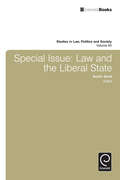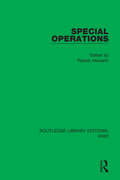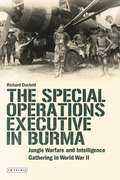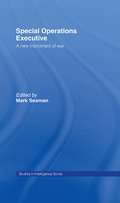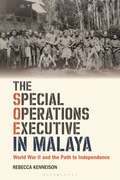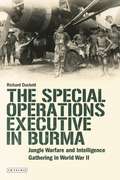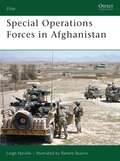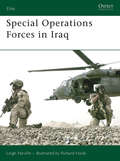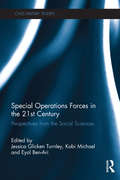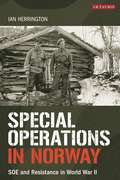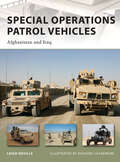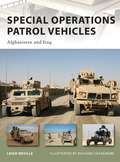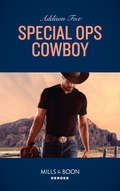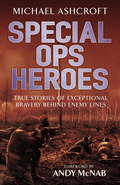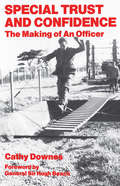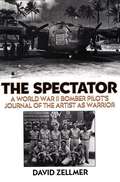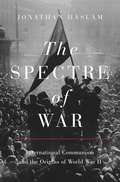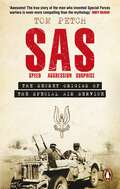- Table View
- List View
Special Issue: Law and the Liberal State (Studies in Law, Politics, and Society #65)
by Austin SaratThis special issue of Studies in Law, Politics and Society focuses on law and the liberal state; presenting an interdisciplinary and multifaceted approach to analysis of law and liberty. The first chapters focus on law's direct relationship with the American liberal state. John P. Anderson defends John Rawl's pragmatism; Adelaide Villmoare and Peter Stillman consider the 'Janus faces of law', a double vision of law where both sides of the face adhere to one another through neoliberalism; and Timothy Delaune examines jury nullification. The remaining chapters then go on to consider specific applications of the law within society. Susan Burgess provides a critical account of what implications the inclusion of gays in the US military has for understanding the means by which the liberal state uses law to include the previously excluded. Daniel Skinner then problematizes the body politics of American liberalism, as viewed through the lens of health policy and the final chapter from Beau Breslin and Katherine Cavanaugh explores how various legal and judicial policies have highlighted the clash between the state's imperial authority and Native American narratives.
Special Operations (Routledge Library Editions: WW2 #33)
by Patrick HowarthThis book, first published in 1955, collects together accounts of some of the men and women who served as members of the remarkable S.O.E. This organisation was set up by Britain to encourage, help and organise resistance movements in occupied countries, and this book provides a valuable record of the types of people involved, and the work that they undertook.
Special Operations (Routledge Library Editions: WW2 #33)
by Patrick HowarthThis book, first published in 1955, collects together accounts of some of the men and women who served as members of the remarkable S.O.E. This organisation was set up by Britain to encourage, help and organise resistance movements in occupied countries, and this book provides a valuable record of the types of people involved, and the work that they undertook.
The Special Operations Executive: Jungle Warfare and Intelligence Gathering in WW2 (International Library of Twentieth Century History #130)
by Richard DuckettIn the mountains and jungles of occupied Burma during World War II, British special forces launched a series of secret operations, assisted by parts of the Burmese population. The men of the SOE, trained in sabotage and guerrilla warfare, worked in the jungle, deep behind enemy lines, to frustrate the puppet Burmese government of Ba Maw and continue the fight against Hirohito's Japan in a theatre starved of resources. Here, Richard Duckett uses newly declassified documents from the National Archives to reveal for the first time the extent of British special forces' involvement - from the 1941 operations until beyond Burma's independence from the British Empire in 1948. Duckett argues convincingly that 'Operation Character' and 'Operation Billet' - large SOE missions launched in support of General Slim's XIV Army offensive to liberate Burma - rank among the most militarily significant of the SOE's secret missions. Featuring a wealth of photographs and accompanying material never before published, including direct testimony recorded by veterans of the campaign and maps from the SOE files, The SOE in Burma tells a compelling story of courage and struggle in during World War II
Special Operations Executive: A New Instrument of War (Studies in Intelligence)
by Mark SeamanThis unique book presents an accurate and reliable assessment of the Special Operations Executive (SOE). It brings together leading authors to examine the organization from a range of key angles. This study shows how historians have built on the first international conference on the SOE at the Imperial War Museum in 1998. The release of many records then allowed historians to develop the first authoritative analyses of the organization’s activities and several of its agents and staff officers were able to participate. Since this groundbreaking conference, fresh research has continued and its original papers are here amended to take account of the full range of SOE documents that have been released to the National Archives. The fascinating stories they tell range from overviews of work in a single country to particular operations and the impact of key personalities. SOE was a remarkably innovative organization. It played a significant part in the Allied victory while its theories of clandestine warfare and specialised equipment had a major impact upon the post-war world. SOE proved that war need not be fought by conventional methods and by soldiers in uniform. The organization laid much of the groundwork for the development of irregular warfare that characterized the second half of the twentieth century and that is still here, more potent than ever, at the beginning of the twenty-first. This book will be of great interest to students of World War II history, intelligence studies and special operations, as well as general readers with an interest in SOE and World War II.
Special Operations Executive: A New Instrument of War (Studies in Intelligence)
by Mark SeamanThis unique book presents an accurate and reliable assessment of the Special Operations Executive (SOE). It brings together leading authors to examine the organization from a range of key angles. This study shows how historians have built on the first international conference on the SOE at the Imperial War Museum in 1998. The release of many records then allowed historians to develop the first authoritative analyses of the organization’s activities and several of its agents and staff officers were able to participate. Since this groundbreaking conference, fresh research has continued and its original papers are here amended to take account of the full range of SOE documents that have been released to the National Archives. The fascinating stories they tell range from overviews of work in a single country to particular operations and the impact of key personalities. SOE was a remarkably innovative organization. It played a significant part in the Allied victory while its theories of clandestine warfare and specialised equipment had a major impact upon the post-war world. SOE proved that war need not be fought by conventional methods and by soldiers in uniform. The organization laid much of the groundwork for the development of irregular warfare that characterized the second half of the twentieth century and that is still here, more potent than ever, at the beginning of the twenty-first. This book will be of great interest to students of World War II history, intelligence studies and special operations, as well as general readers with an interest in SOE and World War II.
The Special Operations Executive in Malaya: World War II and the Path to Independence
by Rebecca KenneisonDuring World War II, agents of the Special Operations Executive (SOE) infiltrated Japanese-occupied Malaya. There they worked with Malayan guerrilla groups, including the communist-sponsored Malayan Peoples Anti-Japanese Army (MPAJA), regarded as the precursor of the communist insurgent army of the Malayan Emergency. This book traces the development of SOE's Malayan operations, and analyses the interactions between SOE and the various guerrilla groups. It explores the reasons for and the extent of Malay disillusionment with Japanese rule, and demonstrates how guerrilla service acted as a training ground for some later Malay leaders of the independent nation. However, the reports written about the MPAJA by SOE operatives just after the war failed to draw out the likely future threat posed by the communists to the returning colonial administration. Rebecca Kenneison shows that the British possessed a wealth of local information, but failed to convert it into active intelligence in the period prior to the Malayan Emergency. In doing so she provides new insights into the impact of SOE on Malayan politics, the nature of Malayan communism's challenge to colonial rule, and British post-war intelligence in Malaya.
The Special Operations Executive in Malaya: World War II and the Path to Independence
by Rebecca KenneisonDuring World War II, agents of the Special Operations Executive (SOE) infiltrated Japanese-occupied Malaya. There they worked with Malayan guerrilla groups, including the communist-sponsored Malayan Peoples Anti-Japanese Army (MPAJA), regarded as the precursor of the communist insurgent army of the Malayan Emergency. This book traces the development of SOE's Malayan operations, and analyses the interactions between SOE and the various guerrilla groups. It explores the reasons for and the extent of Malay disillusionment with Japanese rule, and demonstrates how guerrilla service acted as a training ground for some later Malay leaders of the independent nation. However, the reports written about the MPAJA by SOE operatives just after the war failed to draw out the likely future threat posed by the communists to the returning colonial administration. Rebecca Kenneison shows that the British possessed a wealth of local information, but failed to convert it into active intelligence in the period prior to the Malayan Emergency. In doing so she provides new insights into the impact of SOE on Malayan politics, the nature of Malayan communism's challenge to colonial rule, and British post-war intelligence in Malaya.
The Special Operations Executive (SOE) in Burma: Jungle Warfare and Intelligence Gathering in WW2
by Richard DuckettIn the mountains and jungles of occupied Burma during World War II, British special forces launched a series of secret operations, assisted by parts of the Burmese population. The men of the SOE, trained in sabotage and guerrilla warfare, worked in the jungle, deep behind enemy lines, to frustrate the puppet Burmese government of Ba Maw and continue the fight against Hirohito's Japan in a theatre starved of resources. Here, Richard Duckett uses newly declassified documents from the National Archives to reveal for the first time the extent of British special forces' involvement - from the 1941 operations until beyond Burma's independence from the British Empire in 1948. Duckett argues convincingly that `Operation Character' and `Operation Billet' - large SOE missions launched in support of General Slim's XIV Army offensive to liberate Burma - rank among the most militarily significant of the SOE's secret missions. Featuring a wealth of photographs and accompanying material never before published, including direct testimony recorded by veterans of the campaign and maps from the SOE files, The SOE in Burma tells a compelling story of courage and struggle in during World War II
Special Operations Forces in Afghanistan (Elite)
by Ramiro Bujeiro Leigh NevilleIntelligence specialist Leigh Neville identifies, describes and illustrates the Special Operations Forces (SOF) of the British, American and other Coalition forces committed to the 'War on Terror' in Afghanistan since 2001, providing a fascinating insight into specific operations detailing weapons, equipment and experiences in combat. With a surprising amount of recently declassified material from government departments that are yet to be published in the mass media, this is a ground-breaking analysis of the largest mobilization of Special Forces in recent history. With extensive first-hand accounts providing an eyewitness perspective of the fighting on the ground and including information on the British SAS, the US Delta Force, Australian and Canadian special forces as well as MI6 and CIA operational units, this book provides a crucial study of their skills and successes amidst the Afghan mountains.
Special Operations Forces in Afghanistan: Afganistan 2001-2007 (Elite #163)
by Leigh NevilleIntelligence specialist Leigh Neville identifies, describes and illustrates the Special Operations Forces (SOF) of the British, American and other Coalition forces committed to the 'War on Terror' in Afghanistan since 2001, providing a fascinating insight into specific operations detailing weapons, equipment and experiences in combat. With a surprising amount of recently declassified material from government departments that are yet to be published in the mass media, this is a ground-breaking analysis of the largest mobilization of Special Forces in recent history. With extensive first-hand accounts providing an eyewitness perspective of the fighting on the ground and including information on the British SAS, the US Delta Force, Australian and Canadian special forces as well as MI6 and CIA operational units, this book provides a crucial study of their skills and successes amidst the Afghan mountains.
Special Operations Forces in Iraq (Elite #170)
by Leigh Neville Richard HookThe companion volume to Elite 163: Special Operations Forces in Afghanistan, Leigh Neville now turns his expert analysis to the Special Operations Forces (SOF) of the US and Coalition allies serving in Iraq since 2003. Filled with recently declassified material, first hand accounts, and unique photographs, this book offers a rare look at the largest mobilisation of Special Forces in recent history. Examining in detail the US Delta Force, the British SAS, Australian and Canadian Special Forces as well as CIA and MI6 operational units, this book provides a crucial study of their skills and success in Iraq, from the Battle of Debecka to storming the safe house of Uday Hussein. In a controversial war that has been plagued by high fatalities and military blunders, this book highlights the successes enjoyed by Special Forces Operatives.
Special Operations Forces in the 21st Century: Perspectives from the Social Sciences (Cass Military Studies)
by Jessica Glicken Turnley Kobi Michael Eyal Ben-AriThis book sets out the major social scientific approaches to the study of Special Operations Forces. Despite consistent downsizing, over the past two decades the armed forces of the industrial democracies have seen a huge growth in Special Operations Forces (SOF). Through increasing numbers of personnel and more frequent deployments, SOF units have wielded considerable influence in conflicts around the world, with senior SOF officers having led major strategic operations. This increased presence and unprecedented expansion for SOF is largely a result of the ‘new’ kinds of conflicts that have emerged in the 21st century. At the same time, even with this high profile in the military, policy and media and popular cultural arenas, there is relatively little social scientific research on SOF. This volume aims to fill this gap by providing a series of studies and analyses of SOF across the globe, since the end of World War II. Analysing SOF at the micro, mezzo and macro levels provides broad and diverse insights. Moreover, the volume deals with new issues raised by the use of such forces that include emerging modes of civilian control, innovative organizational forms and the special psychological characteristics necessitated by SOF operatives. It concludes with a discussion of a question which continues to be debated in today’s militaries: what makes SOF ‘special’? Filling a clear gap in the literature, this book will be of much interest to students of strategic studies, civil-military relations, irregular warfare, security studies, and international relations.
Special Operations Forces in the 21st Century: Perspectives from the Social Sciences (Cass Military Studies)
by Jessica Glicken Turnley Kobi Michael Eyal Ben-AriThis book sets out the major social scientific approaches to the study of Special Operations Forces. Despite consistent downsizing, over the past two decades the armed forces of the industrial democracies have seen a huge growth in Special Operations Forces (SOF). Through increasing numbers of personnel and more frequent deployments, SOF units have wielded considerable influence in conflicts around the world, with senior SOF officers having led major strategic operations. This increased presence and unprecedented expansion for SOF is largely a result of the ‘new’ kinds of conflicts that have emerged in the 21st century. At the same time, even with this high profile in the military, policy and media and popular cultural arenas, there is relatively little social scientific research on SOF. This volume aims to fill this gap by providing a series of studies and analyses of SOF across the globe, since the end of World War II. Analysing SOF at the micro, mezzo and macro levels provides broad and diverse insights. Moreover, the volume deals with new issues raised by the use of such forces that include emerging modes of civilian control, innovative organizational forms and the special psychological characteristics necessitated by SOF operatives. It concludes with a discussion of a question which continues to be debated in today’s militaries: what makes SOF ‘special’? Filling a clear gap in the literature, this book will be of much interest to students of strategic studies, civil-military relations, irregular warfare, security studies, and international relations.
Special Operations in Norway: SOE and Resistance in World War II (International Library of War Studies)
by Ian HerringtonBetween 1940 and 1945, Britain's Special Operations Executive (SOE) carried out sabotage and organised resistance across occupied Europe. Over 5 years, SOE sent over 500 agents into Norway to carry out a range of operations from sabotage and assassination to attempts to organise an underground guerrilla army. This book is the first multi-archival, international academic analysis of SOE's policy and operations in Norway and the influences that shaped them, challenging previous interpretations of the relationship between this organisation and both the Norwegian authorities and the Milorg resistance movement.
Special Operations in Norway: SOE and Resistance in World War II (International Library of War Studies)
by Ian HerringtonBetween 1940 and 1945, Britain's Special Operations Executive (SOE) carried out sabotage and organised resistance across occupied Europe. Over 5 years, SOE sent over 500 agents into Norway to carry out a range of operations from sabotage and assassination to attempts to organise an underground guerrilla army. This book is the first multi-archival, international academic analysis of SOE's policy and operations in Norway and the influences that shaped them, challenging previous interpretations of the relationship between this organisation and both the Norwegian authorities and the Milorg resistance movement.
Special Operations Patrol Vehicles: Afghanistan and Iraq (New Vanguard #179)
by Leigh NevilleThe patrol vehicles used by Special Operations Forces in Afghanistan and Iraq vary quite dramatically between the theatres as well as amongst the Coalition members, and have been developed and upgraded to meet the demands of the deployment. Covering all the major Coalition nations, Leigh Neville continues his look at the elite forces deployed in Operations Enduring Freedom and Iraqi Freedom, with this analysis of their vehicles. Tracing the evolution of the vehicle types, from their historical precedents, through their designs to their operational developments, he discusses their advantages and disadvantages, along with their tactical employment. From the mine-protected vehicles used to counter the IED threat in Iraq, the use of Strykers as armoured raiding platforms by the US Rangers, to the civilian vehicles adapted for military service by both Coalition troops and Private Military Contractors in the regions, this book uses rare in-theatre photographs and colour artwork to show the variety and inventiveness of the patrol vehicles being used in combat today.
Special Operations Patrol Vehicles: Afghanistan and Iraq (New Vanguard)
by Leigh Neville Richard ChasemoreThe patrol vehicles used by Special Operations Forces in Afghanistan and Iraq vary quite dramatically between the theatres as well as amongst the Coalition members, and have been developed and upgraded to meet the demands of the deployment. Covering all the major Coalition nations, Leigh Neville continues his look at the elite forces deployed in Operations Enduring Freedom and Iraqi Freedom, with this analysis of their vehicles. Tracing the evolution of the vehicle types, from their historical precedents, through their designs to their operational developments, he discusses their advantages and disadvantages, along with their tactical employment. From the mine-protected vehicles used to counter the IED threat in Iraq, the use of Strykers as armoured raiding platforms by the US Rangers, to the civilian vehicles adapted for military service by both Coalition troops and Private Military Contractors in the regions, this book uses rare in-theatre photographs and colour artwork to show the variety and inventiveness of the patrol vehicles being used in combat today.
Special Ops Heroes
by Michael AshcroftSpecial Ops Heroes tells the extraordinary stories behind Lord Ashcroft's collection of SAS and other Special Forces medals - the largest of its kind in the world. The action-packed stories span some sixty years from the exploits of the newly-formed SAS early in the Second World War to the end of the twentieth century. It features several remarkable groups of medals for some of the most audacious escapades of the Second World War as well as more recent medals awarded for bravery in Northern Ireland, Darfur and at the Iranian Embassy Seige in London.
Special Trust and Confidence: The Making of an Officer
by Cathy DownesThis is an examination and an analysis of the systems of recruitment, selection, education and training for junior officers in the British Armed Forces. It is a study based around four core institutions: The Royal Military Academy, Sandhurst, The Britannia Royal Naval College, Dartmouth, the Department of Initial Officer Training, Royal Air Force College, Cranwell and the Officers Training Wing, Commando Training Centre, Royal Marines, Lympstone. The conclusions reveal the enduring dilemmas involved in the preparation of officer aspirants for entry to the British military profession.
Special Trust and Confidence: The Making of an Officer
by Cathy DownesThis is an examination and an analysis of the systems of recruitment, selection, education and training for junior officers in the British Armed Forces. It is a study based around four core institutions: The Royal Military Academy, Sandhurst, The Britannia Royal Naval College, Dartmouth, the Department of Initial Officer Training, Royal Air Force College, Cranwell and the Officers Training Wing, Commando Training Centre, Royal Marines, Lympstone. The conclusions reveal the enduring dilemmas involved in the preparation of officer aspirants for entry to the British military profession.
The Spectator: A World War II Bomber Pilot's Journal of the Artist as Warrior
by David ZellmerFrom Greenwich Village to Guadalcanal in just over a year, David Zellmer would find piloting a B-24 bomber in the South Pacific a far cry from his life as a fledgling member of the Martha Graham Dance Company. He soon discovered the unimagined thrills of first flights and the astonishment of learning that an aerial spin was merely a vertical pirouette which one spotted on a barn thousands of feet below, instead of on a doorknob in Martha's studio. Reconstructed from letters home, this captivating account traces Zellmer's journey from New York to the islands of the South Pacific as the 13th Air Force battled to push back the Japanese invaders in 1943 and 1944.Spurred to action by encouraging letters from Martha Graham, who urges him to document his participation in the great tragic play of the Second World War, Zellmer struggles to come to terms with the fears and joys of flying, of killing and being killed. Each stage of the battle takes him farther and farther from those he loves, until the soft night breezes and moon-splashed surf no longer work their magic. From bombing runs against Truk, the infamous headquarters of the Japanese Fleet, to much savored slivers of civilization in Auckland and Sydney, the young pilot bemoans a gnawing concern at a loss of sensation, the prospect of life—not as a performer, but as a spectator. With distant memories of life on the stage, he finds that only the threat of death can bring the same intensity of feeling.
The Spectre of War: International Communism and the Origins of World War II (Princeton Studies in International History and Politics #184)
by Jonathan HaslamA bold new history showing that the fear of Communism was a major factor in the outbreak of World War IIThe Spectre of War looks at a subject we thought we knew—the roots of the Second World War—and upends our assumptions with a masterful new interpretation. Looking beyond traditional explanations based on diplomatic failures or military might, Jonathan Haslam explores the neglected thread connecting them all: the fear of Communism prevalent across continents during the interwar period. Marshalling an array of archival sources, including records from the Communist International, Haslam transforms our understanding of the deep-seated origins of World War II, its conflicts, and its legacy.Haslam offers a panoramic view of Europe and northeast Asia during the 1920s and 1930s, connecting fascism’s emergence with the impact of the 1917 Bolshevik Revolution. World War I had economically destabilized many nations, and the threat of Communist revolt loomed large in the ensuing social unrest. As Moscow supported Communist efforts in France, Spain, China, and beyond, opponents such as the British feared for the stability of their global empire, and viewed fascism as the only force standing between them and the Communist overthrow of the existing order. The appeasement and political misreading of Nazi Germany and fascist Italy that followed held back the spectre of rebellion—only to usher in the later advent of war.Illuminating ideological differences in the decades before World War II, and the continuous role of pre- and postwar Communism, The Spectre of War provides unprecedented context for one of the most momentous calamities of the twentieth century.
Speed, Aggression, Surprise: The Untold Secret Origins of the SAS
by Tom Petch'Awesome!' ANDY McNAB | 'You must read this book' Colonel TIM COLLINS OBE | 'Extraordinary' Sir RANULPH FIENNES Forget what you thought you knew. Discover the REAL story of how the SAS was created.From ex-SAS Commander Tom Petch, this is the never-before-told story of how the world's preeminent Special Forces came into existence. Flashing between dramatic accounts from the frontlines and power negotiations in Westminster, it's an adventure that reaches from the trenches of the Western Front to piracy in the deserts of North Africa, to the final assault on Germany.Drawing on hidden archives and told with captivating drama, it focuses on two characters largely overlooked in the traditional narrative - Dudley Clarke the mastermind, and William Fraser the frontline operator. Without them there would never have been an SAS.'Gripping and fascinating... Packed with unforgettable characters and thrilling adventures' WILL IREDALE, bestselling author of The Pathfinders
